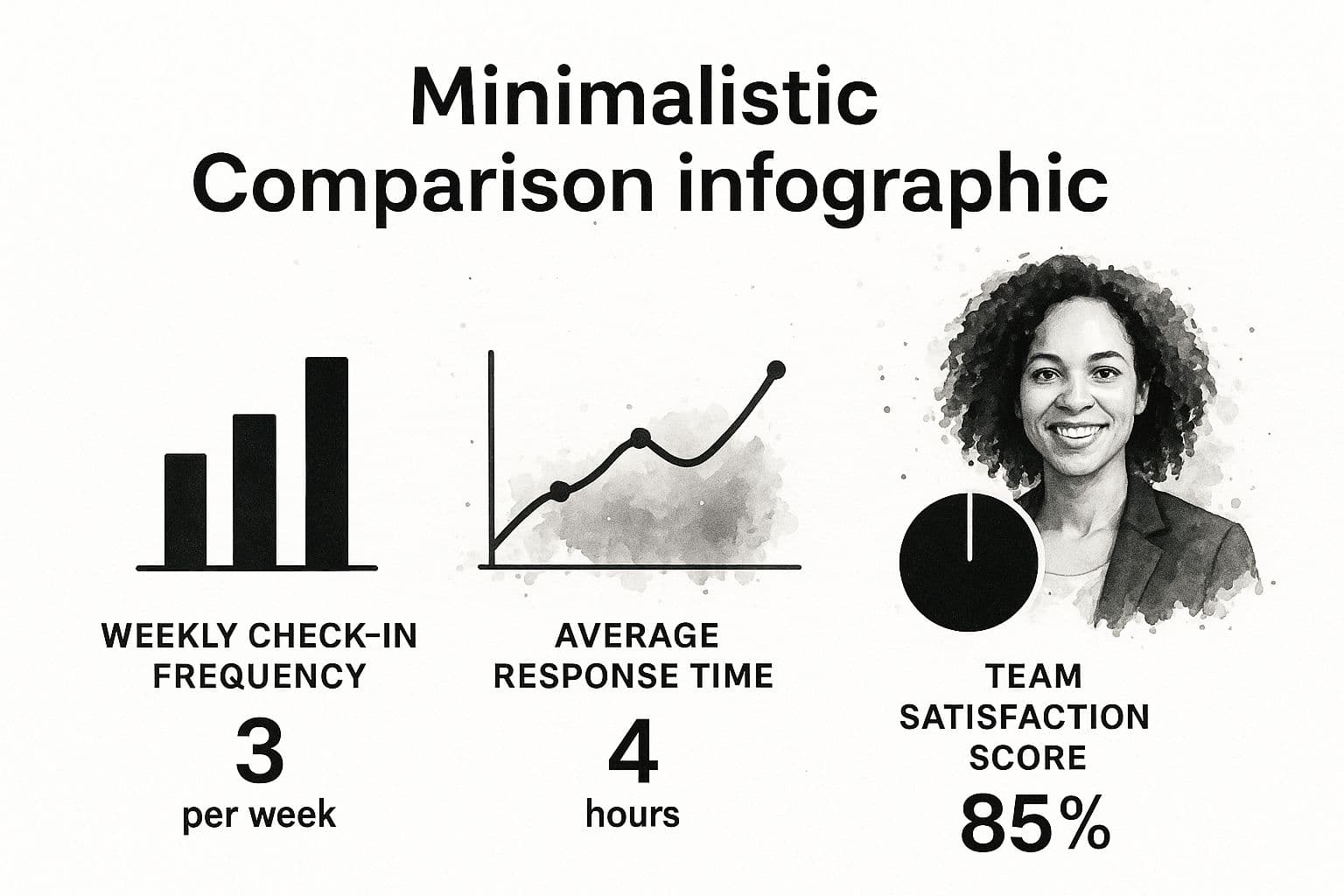Learn how to improve team communication with proven strategies. Boost collaboration and productivity today to achieve your goals!
July 28, 2025 (4mo ago)
How to Improve Team Communication for Better Results
Learn how to improve team communication with proven strategies. Boost collaboration and productivity today to achieve your goals!
← Back to blog
Great team communication isn't just about talking more. It’s about building a predictable, reliable system where the right information gets to the right people, exactly when they need it. It’s less about constant chatter and more about creating a clear, intentional flow of information.
Why Great Communication Is Your Team’s Superpower
Let’s be honest: fuzzy communication costs a lot more than just wasted time. It hits your budget, your team's morale, and your project's momentum. Too many leaders dismiss communication as a "soft skill," but the highest-performing teams I've worked with treat it as a core business function. The road to better results is paved with clear, purposeful interaction.
The fallout from getting this wrong is huge. A shocking 86% of employees and executives** point to poor communication as the number one reason for workplace failures. But the flip side is just as compelling. Teams that nail their communication can see productivity jump by as much as 25%. That's not a small gain; it turns a common liability into a serious competitive edge.
What High-Performing Teams Do Differently
Exceptional communication doesn't just happen by chance. From what I've seen, it stands on three core pillars that reinforce each other, creating an environment where real collaboration can flourish.
-
Clear Protocols: This is all about setting the "rules of the road" for how your team talks. It means deciding what goes where—so a critical project update doesn't get buried in a casual chat channel or a massive email thread.
-
Smart Tech Choices: It's not about throwing more apps at the problem. It’s about using the right tools in the right way. A central hub like Fluidwave can become your team's single source of truth, cutting out the guesswork and redundant work.
-
A Culture of Trust: The fanciest software in the world is useless if your team members are afraid to speak up. Building psychological safety is what allows for honest feedback, quick problem-solving, and true innovation.
To really get the most out of your people, you have to actively build and refine your team collaboration strategies. These are the practical methods that bring a culture of strong communication to life.
The real goal here is to move from a state of reactive, chaotic communication to a proactive, structured system. When people don't have to second-guess how or where to share information, they can focus their brainpower on what they do best.
The Real Cost of Communication Breakdowns
Let's talk about what happens when communication breaks down. It's not just a minor annoyance; it has a direct, measurable impact on your business. Siloed information, mixed signals, and vague requests don't just create friction—they can grind entire projects to a halt and tank team morale. Every little misunderstanding has a real-world cost that shows up on your P&L and in your team's well-being.
The table below breaks down some of the most common issues and their consequences.
The Real Cost of Communication Breakdowns
| Communication Challenge | Operational Impact | Impact on Team |
|---|---|---|
| Information Silos | Project delays due to missing information; duplicated work and wasted resources. | Frustration and a sense of being disconnected from the larger team goals. |
| Vague Instructions | Increased errors and rework; missed deadlines and budget overruns. | Decreased confidence, confusion over priorities, and heightened stress. |
| Unclear Channels | Important messages are missed; slow response times on critical issues. | Burnout from notification overload; anxiety about missing important updates. |
Seeing these impacts laid out makes it clear: investing in better communication isn't a luxury, it's a fundamental part of running a successful and healthy business.
Build Your Foundation with Clear Communication Protocols

If you’ve ever found yourself digging through a mountain of emails, chat messages, and old meeting notes just to find one simple project update, you already know the cost of communication chaos. Effective team communication isn’t about adding more channels; it's about creating a clear playbook for how and when to use the ones you have. Laying this groundwork with defined communication protocols is one of the most direct ways to boost your team's effectiveness.
A communication protocol is essentially a shared agreement on how your team talks to each other. It’s a guide—not a rigid rulebook—that clarifies which tool to use for what, sets fair expectations for response times, and outlines how to flag something as urgent. Think of it like creating dedicated lanes on a highway. Instead of everyone swerving around, causing confusion and delays, each car moves smoothly in its own lane, all heading toward the same destination.
The fallout from not having this clarity is real. Poor communication is a direct cause of 28% of project delays. What makes this worse is that only 18% of employees ever get formal feedback on their communication skills, leaving most people to figure it out on their own.
Define the Purpose of Each Channel
The first move is to put an end to the "all channels for everything" mindset. Get together with your team and assign a primary job to each communication tool in your stack. This single decision eliminates a ton of daily guesswork and frees up mental energy for everyone.
For instance, a marketing team's protocol might look something like this:
- Fluidwave Tasks: This is the home for all official project briefs, assignments, and feedback. It becomes the single source of truth for all work, ensuring no brilliant idea or critical comment gets lost.
- Team Chat (Slack/Teams): Perfect for quick, informal questions and genuinely urgent updates that need a fast response. It’s not the place for major decisions or detailed feedback that belongs in Fluidwave.
- Email: Reserved for formal, external communication with clients or partners and for major company-wide announcements. It's not for day-to-day internal task management.
- Video Calls: Used for weekly syncs, complex problem-solving sessions, and one-on-one check-ins where nuance and human connection are key.
By defining these roles, you stop critical project briefs from getting buried in a sea of GIFs and prevent urgent questions from languishing in an email inbox.
Set Realistic Response Time Expectations
One of the biggest sources of workplace anxiety is the unspoken pressure to reply instantly. This "always-on" culture is a fast track to burnout and shallow, distracted work. A solid communication protocol tackles this head-on by setting clear and reasonable expectations for response times.
A protocol isn't about policing every word. It's about providing guardrails that keep communication flowing smoothly, reducing the daily friction that wears teams down. It replaces ambiguity with predictability.
For example, your team could agree to something like this:
- Team Chat: Acknowledge within 1-2 hours during your workday.
- Fluidwave Task Comments: Respond by the end of the business day.
- Email: Reply within 24 business hours.
Guidelines like these give your team permission to disconnect from notifications and dive into deep, focused work, confident they won't miss anything that truly needs their immediate attention.
Create Templates for Key Interactions
To strip away even more ambiguity, it helps to create simple templates for recurring communication, like project kickoffs or bug reports. This ensures consistency and makes sure everyone provides the necessary information right from the start.
Here's a sample Project Kickoff Template you could build in Fluidwave:
- Project Goal: What is the one key outcome we're aiming for?
- Key Stakeholders: Who makes the final call? Who just needs to be kept in the loop?
- Timeline & Milestones: What are the major deadlines we need to hit?
- Deliverables: What specific items will we be creating?
- Known Risks: What potential hurdles should we watch out for?
Using a standardized template inside a shared tool like Fluidwave ensures every single project kicks off with complete clarity. To make sure these new habits stick, consider interactive training. You can explore 8 powerful scenarios for training teams that help people practice and internalize these new ways of working together.
By setting up these foundational protocols, you can transform your team’s communication from a source of stress into a powerful engine for productivity and alignment.
Master Your Communication Technology Stack

It’s a common trap: a team’s communication feels clunky, so management throws another app at the problem. But more often than not, this just adds to the chaos. The real breakthrough doesn't come from having more tools; it comes from mastering the ones you have.
When tools are scattered, so is your information. This digital clutter isn't just an annoyance; it has a real financial impact. Large companies lose an average of $62.4 million a year from communication breakdowns alone. Even on a smaller scale, 46% of employees say they lose up to 40 minutes a day just trying to get clarification on confusing requests.
That’s a massive drain on productivity, all because of a disorganized tech stack. The goal is to move from a cluttered toolbox to a streamlined, central hub where work actually gets done.
Conduct a Tech Stack Audit
First things first, you need a clear picture of what's actually being used. It’s time for a tech stack audit. This isn't about pointing fingers; it's a discovery process. You'll likely uncover "shadow IT"—those unofficial apps your teams started using on their own to get by.
Get your team together and map out every tool they use for communication and collaboration. Think about:
- Project Management: Where do tasks live and get tracked? (e.g., Fluidwave, Asana, Monday)
- Instant Messaging: Where do quick chats happen? (e.g., Slack, Microsoft Teams)
- Document Storage: Where are files stored and co-edited? (e.g., Google Drive, OneDrive)
- Email: How is email used for internal versus external conversations?
- Video Calls: What’s the default for virtual meetings? (e.g., Zoom, Google Meet)
Once you have this inventory, ask your team why they use each tool. What specific problem does it solve for them? Their answers will reveal what features they truly value and where the biggest overlaps and redundancies are.
Consolidate Around a Central Hub
With your audit insights in hand, the next step is to consolidate. You need to designate a primary platform to act as your team's central nervous system—the one place everyone knows to go for project information. This is how you stop the endless hunt for that one file or decision.
A platform like Fluidwave is built for this very purpose, combining task management, real-time collaboration, and delegation all in one place. By making it your "single source of truth," you create a transparent, searchable record of every project.
A single source of truth doesn't mean you can only use one tool. It means you have one primary hub where all work-related information is anchored, and other tools integrate with it, rather than compete against it.
The benefits become obvious almost immediately. Instead of a project brief getting buried in an email chain while feedback flies around in Slack, everything—the brief, the discussion, the final sign-off—lives right inside the project task in Fluidwave. This creates clarity and accountability. When new action items pop up, knowing how to delegate tasks effectively within that same system keeps the project moving without skipping a beat.
Leverage Your Core Tools for Maximum Impact
Getting everyone onto a central hub is a huge win, but mastering your stack means going deeper than just the basic features. Now it’s time to find the functionalities that actively reduce friction and save time. Dig into your core tools and explore features like:
- Automated Notifications: Set up rules to automatically ping team members when a task status changes or a deadline is near. This eliminates the need for all those "just checking in" messages.
- Real-Time Document Collaboration: Use tools that let multiple people edit a document at the same time. This is the single best way to kill version control nightmares for good.
- Searchable Archives: A powerful search function transforms your project hub into a living knowledge base, letting anyone find past conversations, files, or decisions in seconds.
By taking a deliberate approach to auditing, consolidating, and truly learning your tools, you can explore powerful business communication solutions for seamless collaboration. You'll transform your technology from a source of frustration into your greatest asset for clear, efficient teamwork.
Foster a Culture of Psychological Safety and Open Feedback

You can invest in the best communication tools on the market, but they’ll collect dust in a culture of fear. At the end of the day, the human element is what makes or breaks team communication. Without psychological safety—that shared belief that it’s safe to take risks and be vulnerable—people simply won't speak up, offer tough feedback, or admit they made a mistake.
Building this kind of environment isn't about being “nice”; it's a strategic move. When your team feels safe, they bring critical information into the light instead of hiding it to avoid blame. That transparency is what stops small issues from snowballing into project-derailing disasters.
Leaders Must Model Vulnerability First
Psychological safety starts at the top. If leaders only project an image of perfection, they silently signal that mistakes are unacceptable. That kills open dialogue. True leadership means modeling vulnerability, which in turn gives your team permission to be human.
It can be as simple as a project manager starting a meeting by saying, "I was way too optimistic with that timeline, and that's on me. Let's reassess this together." An admission like that does two powerful things: it owns a misstep without pointing fingers and immediately invites collaborative problem-solving.
This approach creates a space where a team member feels comfortable saying, "I'm concerned about this deadline," knowing they won’t be punished for their honesty. It’s a subtle but profound shift from assigning blame to finding solutions together.
A culture of fear is expensive. It fosters a silence that hides risks until it's too late. A culture of safety, on the other hand, surfaces problems early, turning potential disasters into manageable learning opportunities. It’s the bedrock of real agility and innovation.
Make Asking for Feedback a Standard Practice
Don't just wait for feedback to find its way to you; you have to actively and consistently seek it out. When you make asking for input a standard part of your team's rhythm, it proves you genuinely value their perspective.
Try integrating structured feedback into your key interactions:
-
During One-on-Ones: Push beyond simple status updates. Ask direct, open-ended questions like, "What's one thing I could do to make your work easier?" or "Is there anything blocking you that you're hesitant to bring up?"
-
In Team Meetings: Carve out the last five minutes for a quick round-robin. Ask, "What went well this week, and what felt challenging?" This normalizes talking about both wins and struggles.
-
After Project Milestones: Use retrospectives to learn, not to blame. I've found it helps to frame the discussion around three simple questions: "What should we start doing?", "What should we stop doing?", and "What should we continue doing?"
When you do receive feedback—especially if it’s critical—your response is everything. Thank the person for their courage. Listen to understand, not to formulate a rebuttal. This single action reinforces that speaking up is valued and safe, which only encourages more honesty down the line.
Handle Dissent Constructively
Disagreement isn't a sign of a broken team. More often than not, it's a sign of a healthy one where people are engaged enough to challenge ideas. The trick is to manage that dissent constructively so it leads to better outcomes, not personal conflict.
When a team member pushes back on an idea, don't shut it down. Get curious.
Ask questions like, "Tell me more about your concerns," or "What risks are you seeing that I might be missing?" This validates their perspective and allows you to mine their dissent for valuable insights. You're essentially transforming a potential conflict into a collaborative stress test for an idea, which almost always makes it stronger.
By creating this kind of environment, you unlock the full intellectual power of your team and significantly improve operational efficiency by making better, more thoroughly vetted decisions.
Mastering Communication in Remote and Hybrid Teams
When your team is scattered across different locations—and sometimes different time zones—great communication doesn't just happen. It has to be intentionally designed. We've all moved past basic video call etiquette; the real work is tackling the tougher challenges, like proximity bias and making sure every single person has an equal voice, no matter where they're logging in from.
To truly succeed, you need to shift from being "remote-friendly" to "remote-first." What does that mean? It means you design your workflows as if everyone is remote. This simple change levels the playing field, stopping the accidental advantage that in-office folks often have when it comes to information and influence.
The key is structure. When you combine intentional check-ins with clear expectations on response times, you see a direct impact on how satisfied your team feels.

As the data shows, a little bit of structure goes a long way. It’s not about micromanaging; it’s about creating a predictable and fair environment for everyone.
Adopt an Asynchronous-First Mindset
One of the most significant changes you can make for hybrid success is to lean into asynchronous communication. This is all about building workflows that don't require everyone to be online and available at the exact same moment. It’s the practical answer to the constant juggling of different time zones and flexible schedules.
An async-first approach is really about respecting your team's deep work time. Instead of pulling everyone into a meeting for a simple update, try recording a quick video walkthrough with a tool like Loom and posting it in your team’s Fluidwave project. People can then review and leave thoughtful comments on their own schedule.
This doesn’t mean getting rid of real-time meetings. It’s about making them count. When you handle routine updates asynchronously, you free up your synchronous time (like video calls) for the things it’s best for: brainstorming tough problems, hashing out strategy, and simply connecting on a human level.
To make this work, it's crucial to know when to use each communication style. A quick brainstorming session might be perfect for a video call, but a detailed project brief should live in a shared document where people can comment over time.
Here's a quick guide I use with my teams to help decide the best approach.
Synchronous vs. Asynchronous Communication Guide
| Task Type | Recommended Method | Why It Works | Example Tool/Platform |
|---|---|---|---|
| Urgent Crisis Resolution | Synchronous (Video/Phone Call) | Allows for immediate back-and-forth, rapid decision-making, and alignment under pressure. | Zoom, Phone Call |
| Complex Brainstorming | Synchronous (Video Call) | The energy of a live conversation can spark creativity and build on ideas in real time. | Fluidwave Whiteboards, Miro |
| Project Kick-offs | Synchronous (Video Call) | Essential for establishing shared vision, clarifying roles, and building initial team momentum. | Microsoft Teams |
| Detailed Project Updates | Asynchronous (Shared Doc/Project Mgt. Tool) | Gives everyone time to digest information, ask detailed questions, and provide thoughtful feedback. | Fluidwave, Asana |
| General FYIs & Announcements | Asynchronous (Chat/Email) | Distributes information efficiently without disrupting everyone's workflow for something non-urgent. | Slack, Email |
| 1-on-1 Feedback & Check-ins | Both (Hybrid Approach) | Use a shared agenda doc (async) to prepare, then have a live conversation (sync) to connect personally. | Google Docs + Video Call |
Deciding between sync and async isn't just about efficiency; it's about creating a more inclusive and less frantic work culture.
Redesign Meetings for Real Inclusion
Hybrid meetings are notoriously tough. It’s so easy for remote people to feel like they’re just spectators. To fix this, you have to ensure every single person has the same ability to see, hear, and contribute.
- One Person, One Screen: This is a non-negotiable rule. Even if five people are in the same conference room, they each join the call from their own laptop. It puts everyone in the same "Brady Bunch" grid and makes it easier to read cues and jump in.
- Use Digital Tools for Everything: Ditch the physical whiteboard. All brainstorming and note-taking should happen on a shared digital space, like a collaborative document or virtual whiteboard. This way, an idea from a remote teammate has the same visibility as one from the person sitting at the head of the table.
- Assign a "Remote Advocate": Pick someone in each meeting whose job is to keep an eye on the virtual participants. They can watch for virtual raised hands or people unmuting, ensuring those not in the room get a fair chance to speak.
These are the kinds of tactical adjustments that are critical when you need to manage a remote team effectively. They actively fight the feeling of being "othered" that can kill morale.
Be Intentional About Informal Connections
Let's be honest: one of the biggest losses with remote work is the "water cooler" chat. You can't force those spontaneous conversations where people build trust and real rapport, but you can create the right environment for them.
- Set up a dedicated non-work chat channel in Fluidwave or Slack for people to share pictures of pets, talk about hobbies, or discuss the latest binge-worthy show.
- Schedule short, optional "virtual coffees" with no agenda. Just 15 minutes to chat and connect as people, not just colleagues.
These small, intentional efforts go a long way in weaving the social fabric that turns a collection of individuals into a truly connected team.
Answering Your Team Communication Questions
Even with a solid plan, shifting how your team communicates will inevitably bring up some questions and a few hurdles. Knowing how to handle these common challenges is what separates a strategy that sticks from one that fizzles out. Let's walk through some of the most frequent questions I hear from leaders and get you some practical answers to keep things moving forward.
Thinking through these scenarios ahead of time is the best way to anticipate roadblocks and make sure your new communication habits become second nature.
https://www.youtube.com/embed/2y8SA6cLUys
How Do I Get My Team to Actually Use New Tools?
Getting people to adopt a new tool is never about the technology itself; it’s about the “why.” You can’t just drop a platform like Fluidwave into the mix and expect a standing ovation. You have to connect it directly to their daily frustrations—show them exactly how it will tame their chaotic inboxes or put an end to the endless search for the right version of a file.
This is where leadership has to walk the talk. If you introduce a new system for project updates but then turn around and send critical feedback over email, you’ve just undermined the entire effort. Your team will mirror what they see you do. You have to lead by example and commit to using the tool for its intended purpose.
To grease the wheels, run some hands-on training sessions. Create a simple one-page “cheat sheet” they can reference. When you see someone using the tool well, give them a public shout-out. That kind of positive reinforcement goes a long way. Most importantly, keep asking for feedback. When the team sees that a new system genuinely makes their work easier, adoption stops feeling like a mandate and starts feeling like a smart move.
What Is the Best Way to Handle Disagreements?
Let's be clear: healthy disagreement is a sign of a team that cares. The trick is to keep it constructive so it doesn't devolve into personal conflict. The goal is always to tackle the issue head-on, in private, and with the focus squarely on the ideas or the process—never the people.
You have to foster an environment where it’s safe to disagree respectfully. A simple but powerful technique is to encourage everyone to use "I" statements. Think about it: "I was unclear on the deadline for my part" feels completely different from "You were unclear about the deadline." The first opens a discussion; the second puts someone on the defensive.
When managed well, conflict is a creative force. It stress-tests ideas and reveals unseen risks. When managed poorly, it erodes trust and grinds productivity to a halt. The difference lies in focusing on the "what" instead of the "who."
If team members can't find common ground on their own, a manager should step in to mediate. A manager's job here isn't to play judge and jury. It’s to listen, understand both sides, pinpoint the real source of the disconnect, and guide them toward an agreed-upon solution. This process doesn't create friction; it builds the kind of trust that makes a team resilient.
How Can We Measure If Our Communication Is Getting Better?
Measuring something as human as communication requires a mix of hard data and what you can see with your own eyes. You can't rely on just one or the other if you want the full story. A blended approach gives you concrete proof while also capturing the cultural shift you’re aiming for.
Quantitative Metrics to Track:
- Project Delays: Are fewer projects slipping past their deadlines because of communication breakdowns?
- Clarification Requests: Look at your inboxes. Are you seeing fewer messages asking, "What did you mean by this?"
- Task Completion Speed: How quickly are tasks moving from the "To-Do" column to "Done"?
- Meeting Time: Has your total time spent in meetings dropped now that updates are happening asynchronously in a tool like Fluidwave?
Qualitative Indicators to Observe:
- Meeting Engagement: Are more people speaking up, asking questions, and contributing ideas?
- Pulse Surveys: Send out short, anonymous surveys asking direct questions like, "On a scale of 1-5, how clear are your current project priorities?"
- Instances of Rework: Are you noticing fewer moments where work has to be redone simply because the instructions weren't clear the first time?
These observable shifts are powerful signs that your new communication habits are not just being followed, but are actually improving how your team functions together.
How Do We Balance Constant Communication with Burnout?
The objective is not more communication; it's smarter communication. Feeling like you have to be “on” all the time is a fast track to burnout. Protecting your team's ability to focus is one of your most important jobs.
This is where your communication ground rules become invaluable. You need to clearly define what’s truly urgent and what can wait. Using a central hub like Fluidwave for all non-urgent status updates can completely eliminate those disruptive "just checking in" pings and meetings.
Champion the idea of "focus time." Encourage your team to literally block off time on their calendars where they are free from notifications and meetings. The ultimate goal is to make communication predictable. When people know exactly where to find information and when to expect it, they feel empowered to disconnect and do the deep, valuable work that moves the needle.
Ready to build a foundation of clear, organized, and stress-free communication? Fluidwave provides the central hub your team needs to delegate tasks, track progress, and eliminate confusion. See how our intelligent task management can transform your team's productivity by visiting https://fluidwave.com.
Focus on What Matters.
Experience lightning-fast task management with AI-powered workflows. Our automation helps busy professionals save 4+ hours weekly.